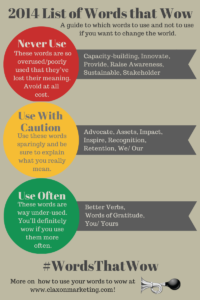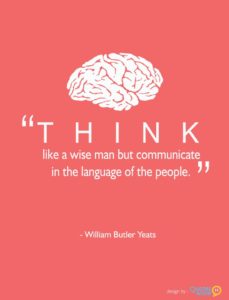 “Don’t use words too big for the subject. Don’t say infinitely when you mean very; otherwise you’ll have no word left when you want to talk about something really infinite.”
“Don’t use words too big for the subject. Don’t say infinitely when you mean very; otherwise you’ll have no word left when you want to talk about something really infinite.”
― C.S. Lewis
Love. This. Quote. It reminds of my favorite quote from Antoine de St-Exupery:
Perfection is reached not when there is nothing left to add, but when there is nothing left to take away.
But–confession–I also love fancy words. I really, truly do. The way they sound. The way you feel when you discover them. The way the letters organize themselves into an unexpected result.
Pernicious for harmful.
Leitmotif for theme.
Gihugic for big. (Okay, you caught me. “Gihugic” isn’t really a word. I made it up. Or someone else did and I heard it and loved it. But isn’t it fun?!)
Fancy words delight me. But I don’t use them much when I write. That’s because fancy words aren’t a super good choice if you’re looking to connect with someone. They’re often a barrier. Rather than being dazzled by your intellect, the person on the receiving end risks being confused or dumb-founded. Neither of which moves your relationship along.
Bonus factoid: Did you know there is actually a Plain Language Law? That’s a real thing. Enacted in 2010, the law requires that federal agencies use “clear Government communication that the public can understand and use.”
Pretty sure fancy words aren’t encouraged by the Plain Language Law.
So loverize yourself silly using fancy words when you’re writing for yourself, or for other people who love fancy words, or when you’re looking to impress your boss with your vast linguistic repertoire (aka big vocabulary). Or when you want a word to pop out and surprise a reader. (Wordifier, anyone?) But make sure that fancy word is surrounded by plain language that is a snap to understand.
*****
Post Readability Stats: Reading Ease: 72, Grade Level: 5.3
**Want to learn more about finding the very best words to advance your mission? Sign up for Winter Quarter at Claxon University!**



 I would maintain that thanks are the highest form of thought; and that gratitude is happiness doubled by wonder. ~G.K. Chesterton
I would maintain that thanks are the highest form of thought; and that gratitude is happiness doubled by wonder. ~G.K. Chesterton



